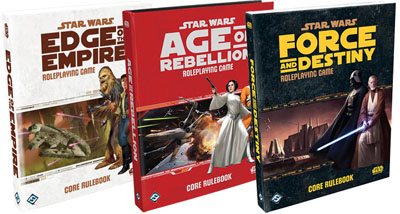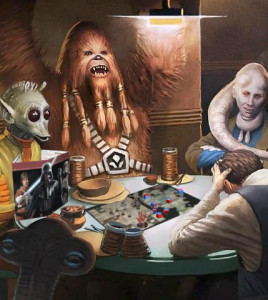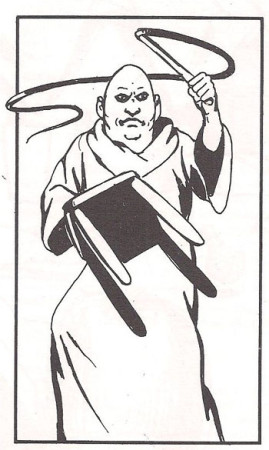 Hello and welcome once again to The Force Does Not Throw Dice, our feature devoted to running tabletop roleplaying games in the galaxy far, far away. This time we are going to be talking about that exciting point in the life of a Star Wars RPG Game Master where they decide to bite the bullet and start their own campaign. “What’s a campaign”, neophytes ask? Well, to use a television example, if an episode is an adventure, the campaign is the whole TV series. Unsurprisingly, most GMs would eventually prefer to create a series rather than one individual episode, so we all end up at that point in due time.
Hello and welcome once again to The Force Does Not Throw Dice, our feature devoted to running tabletop roleplaying games in the galaxy far, far away. This time we are going to be talking about that exciting point in the life of a Star Wars RPG Game Master where they decide to bite the bullet and start their own campaign. “What’s a campaign”, neophytes ask? Well, to use a television example, if an episode is an adventure, the campaign is the whole TV series. Unsurprisingly, most GMs would eventually prefer to create a series rather than one individual episode, so we all end up at that point in due time.
Let’s say that’s the point where you are. You’ve read the manuals, you’ve found a gaming group, you’ve played a character in the game, and you’ve probably run your first one-shot adventures. Now your head is exploding with possibilities: you want to make a sequel to your last adventure, you think that this one character could become a recurring antagonist, and you’ve even started thinking on how everything fits within the vast Sith-Ithorian conspiracy. Excellent! You got the itch to create a long-term storyline, and that’s all you need to start playing. But I’m going to be frank: if you thought that writing your first adventure (if you didn’t use a pre-published one!) was a daunting prospect, you will find out that building your campaign can end up being a real odyssey. It’s going to be a lot of work. If this doesn’t scare you, great: let’s take a peek at how we can try to make the process as painless as possible.
Hi, I am your host, David. I’m a Game Master with twenty-five years of experience, and I’ve successfully run more than twelve campaigns in several systems and settings, three of them at least five years in length. Let’s look at one way to do this!
The high concept (and the lower ones)
I’ve already suggested in this column that before starting a game it’s always a good idea to figure out exactly what you want to say. What kind of story motivates you? What themes? Write an “elevator pitch” describing your campaign’s purpose and goals in just a few lines. Read it aloud, see if it makes any sense, see if it sounds like something you would like to play. Share it with a few people you trust. See what they think about it. (I will happily read your campaign pitches and give you feedback, by the way.)
Then get a sheet of paper and just start writing and sketching whatever comes into your head when you think of your pitch. This is something that I don’t know if any other GMs do, but I think it’s always a good starting point. I like to call this my Master Sheet (because I’m a blowhard) and I basically dump on it everything I want to accomplish during the campaign, every single thing I want the players to experience. I personally find that a text processor doesn’t work as well for this “solo brainstorm” session but, unlike me, you are probably not a Luddite, so have it your way. What goes on the Master Sheet? Literally anything that you’d like to see on the table, anything that gets you excited, no matter how abstract or how specific.
It could be a specific plot point. A type of adventure. A cool plot twist. A movie you wouldn’t mind aping. An emotion you want to elicit. A character trait that you think could be cool. A spaceship name you’ve always liked. An alien species you once drew while bored in class. Even a one-liner you think sounds really badass (not kidding: one of my latest Master Sheets had a dumb one-liner that I eventually ended up using during improvised combat). Eventually, connections between all these things might start to emerge: perfect, write these connections down too! Give it your all, write absolutely everything that gets you pumped up and that you think is going to rock. Why? Because, even if you still don’t know it, this is going to be the best campaign ever. Ever! …Or at the very least, at this point, we are going to pretend so. Don’t forget that aim, the goal to be the very best, the best there ever was, and use it to keep it focused when things start going amok, because they will. Oh, they will…

Something else that can help you keep focused at this point is picturing the perfect ending to your campaign. Do you picture ancient stone starfighters flying over an old Ancient Astronaut Temple while the Cyborg Sith Lord battles the heroes, the Corrupted Monk painfully mutates into an Alchemical Beast, and the Terrible Device slowly sinks into the planet’s core? Amazing: write all that into your Master Sheet. That perfect ending is going to be your reward. You will have to update this vision of the future every few weeks (because who would have expected your smuggler to destroy the Terrible Device with a lucky shot when you teased it to the players?) but try to think of it when things get lost and you want to throw in the towel. It’s the light at the end of the tunnel!
Worldbuilding is overrated
Seriously. I suspect that most Game Masters have an inner novelist inside, because we all just love worldbuilding so much. It’s almost addictive to sit down and write a story that goes back millennia, to draw sector and world maps, to create all major factions and personalities in your setting, to write paragraphs and paragraphs of lore.
And most of the time it’s a waste of your time and resources.
Unless you are a game designer planning to get your setting immediately published (something that wouldn’t work anyway with the Star Wars RPG game without legions of Disney lawyers coming for your kidneys) you are going to end up using perhaps one percent of all that detailed worldbuilding. And that’s not ideal, not remotely. You need to focus your energy on what you are actually going to end up using, or you are going to end up very frustrated when you realize that you are not writing a novel but running a game where you have no direct control over your protagonists (“why oh why did they never visit the Cosmic Abbey and read the Sacred Codex?!”), or worse: you find yourself twisting things so that said protagonists end up doing what you want them to do. That’s one of the traps most first-timers fall into: they get so excited, so in love with their own ideas, that they forget that a GM’s role is to be an intermediary between the players and the gaming world, not to tell the next Thrawn trilogy with their players reading a script on command. You have to use most of your raw creative energy on what you are going to be directly playing: the adventures themselves.

So let the world build itself. Ideally, the world should grow around your campaign, not the other way around. Set that high concept down and then just let it play. Start by designing a small corner of your universe, maybe a seedy border town on an Outer Rim world or a Rebel base in a derelict space station, and design a small introductory adventure that takes place there. You already have the luxury of working in the Star Wars universe, a world loved and known by millions. Your players are presumably already familiar with the basics: they know what hyperspace is, what to expect if they visit Tatooine or Coruscant, and what most popular aliens look like. Most of the worldbuilding has been done for you! Focus on the game! But beware: make sure that you write down everything you and your players reveal or decide about your iteration of the Star Wars world, and that you keep your notes organized. Letting the world build itself is best, but it requires you to be consistent.
And if you’ve still got that worldbuilding itch, consider eventually creating a blog of the campaign, perhaps using some tool like Obsidian Portal, and then start adding additional lore there. That way you can excite your more lore-inclined players, but not have your worldbuilding suck out all your creative energies.
The heroes of the saga
As the player characters are going to be together for more than just one single adventure, the composition of the party becomes extremely important when it comes to building your campaign. Yeah: if you want to excel, one size cannot fit all–you are going to have to build your game around the PCs.
Get all your players together, tell them your pitch (perhaps an edited version of it to avoid spoiling your plot) and help them figure out exactly what characters they want them to play. Try to encourage a modicum of team building: tell each player to choose something that the other characters are not good at, both to increase their survival chances and to make sure each player can have a moment to shine. Talk them into creating a character background as soon as possible, so that you can incorporate it into your campaign as seamlessly as possible. A good and simple trick is to steal a page off West End Games and have each character be connected to at least one of the others. They can be lovers, relatives, former brothers-in-arms, or even former rivals. Make sure to write down all these backgrounds and connections, for they will end up informing your campaign.
It’s always important to draw a few lines in the sand before starting the campaign. Talk also about the ethical framework of the game: love, violence, sex, allegiances, even the Dark Side… you need to make sure everyone is on the same page before starting the campaign. Talk about how much internal conflict everyone is comfortable with: it’s never fun to have a PC stab another PC when the second player thought there was not going to be player-on-player violence, and such an occurrence can potentially destroy your campaign. And don’t be afraid to put your foot down when it comes to what you won’t allow in-game. It’s part of your job.
Developing the story
Now that you have your heroes and you know what you want to do, it’s time to actually start developing your campaign! And we are going to do most of the development as we play. We know how it starts and how we want it to end, now we just have to fill up everything in-between. Easy!
Before doing anything else, take a second look at your high concept. See if after having worked with your players it still holds up. If it doesn’t, change it. No sacred cows here.
Start running the game slowly. Begin running a few small, short, simple, interconnected adventures that are ended in one single session. This interconnection can be as simple as having them all start in the same location and share a few NPCs. But make sure they are short and rewarding: before your plot has kicked in, you will need to keep the players interested in coming back. This doesn’t mean these adventures are just filler, of course, because you are going to be watching like a hawk. Take note of how the PCs play off each other. Notice the type of play they appear to enjoy best, whether they are more comfortable goofing around or mowing down opponents by the dozen. Likewise, see what appears to bore them. Look for types of NPCs they seem to love or detest, and think about whether you can have them play more important rules in the future.
Write your impressions down and keep them next to your Master Sheet: now you have both your design and their input. If your first adventures are short as simple, as I said, you will probably have enough time to start writing new ideas. You will probably start seeing the shape of your campaign come into being.

Once you’ve played a few adventures, ask your players what they’ve liked and disliked during the sessions and mine their comments for ideas. Eventually, your players will start demanging more complexity (and if they don’t let you know don’t hesitate to ask!) and that’s when we’ll start writing down our story arc. Take a look at your Master Sheet, at the notes you’ve taken during and after your first adventures, and at your players’ feedback, and start turning all those disparate things into adventure seeds. Decide how linear or sandbox-like you want your game to be, but as it is your first time you might want to start with something linear and simple: sandbox campaigns require a level of comfort with improvising that most likely you still don’t possess.
As a general rule, the whole should always be greater than the sum of its parts. If your campaign is composed of seven adventures, the overall experience should be more satisfying than if you had run just seven disconnected adventures on a row. How can we achieve that? Luckily we have many tools at our disposal. You can start dropping some subtle foreshadowing for astute players to catch on: let the players meet a merchant that sells stone tools made by the Ancient Astronauts, or have the Monk lament the loss of a student in the same way you intend for him to ultimately meet his end. Show how characters constantly change: they become more skilled (the Young Scout they met ten adventures ago is now a Bitter Veteran), they forge new relationships (few things are funnier than when PCs discover that two NPCs from two different adventures have started dating) or they even completely change allegiances (the PCs’ failure to stop the Cyborg Sith Lord has caused the Friendly Merchant to blame them for the untimely death of his daughter). The world itself should also change as a result of the PCs’ actions. If your smuggler accidentally destroyed the Terrible Device before it devastated the small agrarian planet, have a new settlement eventually be built around the ruins of the crashed superweapon–perhaps even a town named after the smuggler! Don’t keep things static and your players will start feeling like their characters exist in a living world and they’re not just playing a series of unrelated adventures.
While you are writing these first adventures in the campaign proper, make sure to mix things up. Some scenarios might be based on puzzle solving, some might be centered on political debate, and some might be elaborate action set-pieces. You can also try infusing Star Wars with different genres: you can have adventures that have a tinge of romance, a little of horror, perhaps. You should probably avoid running investigative adventures in your first campaign, as maintaining the pacing and information flow can be tremendously tricky for a first-timer—but if you’ve already run one-shot mystery adventures and feel comfortable with them, go for it!
A few things to keep in mind
Be very careful when it comes to your major NPCs. This is another typical mistake of first-time GMs: falling in love with their precious babies. Everyone knows, at least on paper, that non-player characters should never outshine player characters and should never solve any important problems in the story, yet us GMs keep tripping on this stone over and over, sometimes because of lack of patience or because we just feel too proud of our work. Yet few things will destroy your campaign faster than the PCs feeling that the Jedi Master is always there to do their job and patronize them afterwards. These days I’m pretty radical when it comes to this: if I realize that a character is slowly becoming my darling, I just have them exit the stage via a memorable death. There are always more characters where that one came from, and it’s not worth the risk.
Never lose sight of the campaign goal: the majority of adventures should reflect a change in how far or close this goal is. You also need to slowly give your players the information they will need to continue with their saga. I like to keep a diagram where I write down everything they know and everything they still need to know about the campaign’s metaplot for the story to keep going, and I slowly dole it out in the most natural ways I can find. I also like to show instead of telling, as the trope goes: instead of having some NPC tell my players that the Terrible Device was used in the Sith Wars to turn people into desiccated husks, I would have them run into a chamber full with ancient decayed corpses with their eyes unnaturally open and have them figure things out. Nonetheless, try to not have the campaign goal overwhelm your players: add a few “bottle episodes” here or there, maybe related to their characters’ backgrounds or to plotlines that you expected to be secondary but ended up piquing your players’ interest (when you told them that the Friendly Merchant’s daughter had died you did not expect them to drop everything and go hunt down the killer but hey, here we are.)
Also write a few notes on possible side quests: what could happen if the PCs decide to go shopping for a new hero ship, or ideas to add replacement heroes to the party. Keep handy a few lists with pre-generated characters, plus planet, species and starship names: you never know when you are going to end up having to create one of those on the spot, and you want it to feel as seamless as possible. Revise your adventures and your notes all the time to incorporate any new developments. And always, always, always listen to your players for ideas and don’t be afraid to change your plans to match them: be humble enough to admit when they are right because it’s going to be for the betterment of the whole game.
Welcome to die!
Does all of that sound daunting? It should, because it is! Running a campaign is not easy. It eventually becomes easier, but it’s always a lot of work. But don’t be hard on yourself. You are going to mess up. It’s your first campaign, and everyone messes their first campaign up. Sometimes even their second. You will eventually get there, but it will take time. My first campaign? It was so bad I prefer not to talk about it. We’ve all been there.
I’ll close this primer by saying what I always say: eventually, you will find your preferred style of preparing and running a campaign. None of the points exposed above are absolute truths. Some might actually not work for you at all. Some, even, will work at first but end up becoming obstacles (you will eventually stop working towards a predefined end, for example, for your improvisation skills would have become stronger and the risk of railroading your players will go down.) But you can only discover any of this by actually sitting down and deciding to start your own campaign. So, if anything you read here inspired you, close your browser and start drafting. The roleplaying world needs you!
If you find this topic interesting, just let me know. There’s more to be said about this, including my system to easily manage the flow of campaign information and a list of some useful tools for campaign design and management. Until next time!
